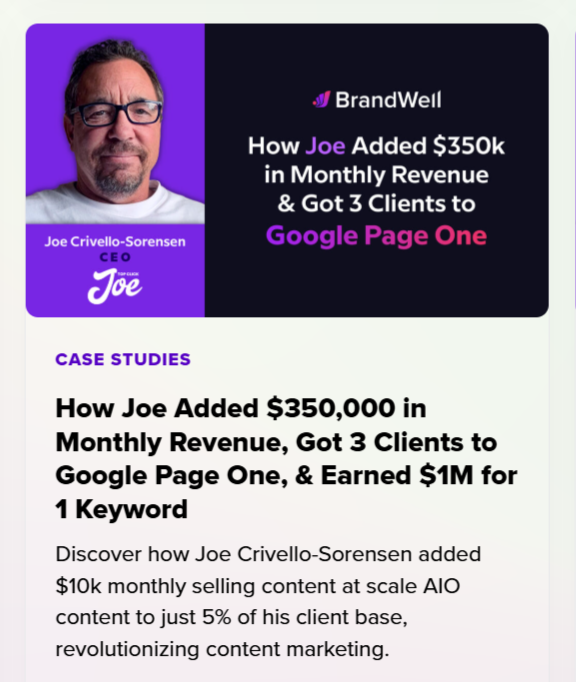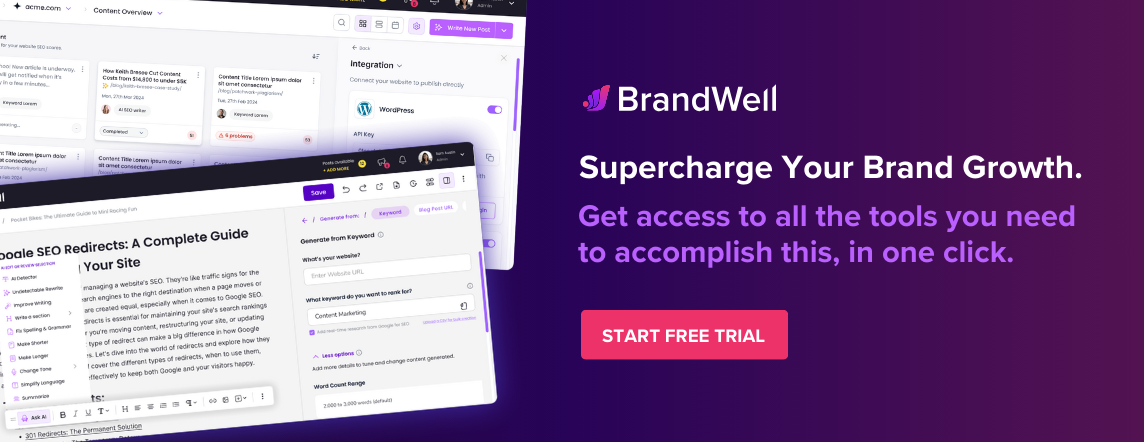Discover top guides, trends, tips and expertise from AIO Writers
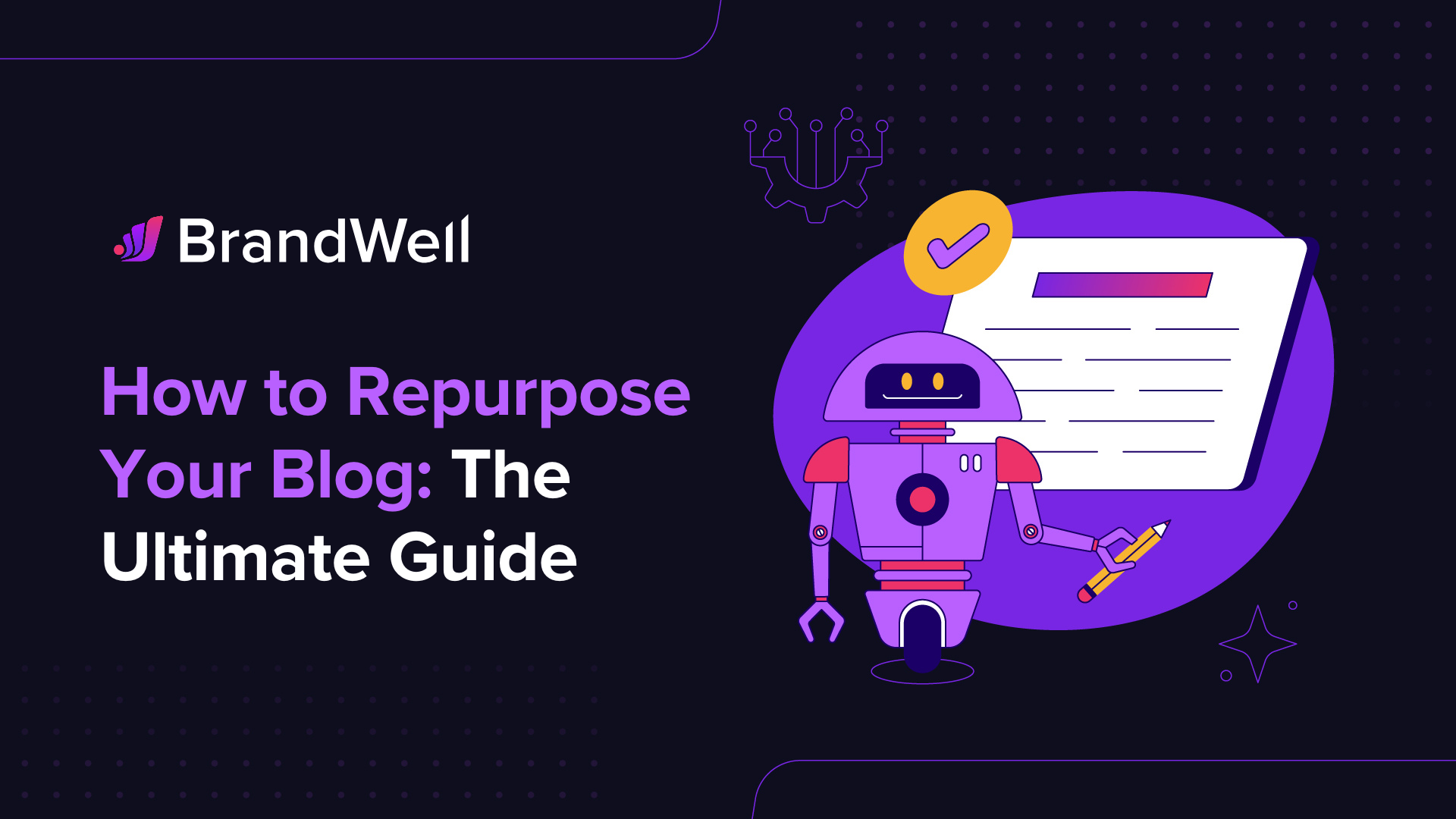
Imagine making a huge pot of chili. You enjoy a bowl today, but what about the rest? You could let it sit in the fridge and forget about it (we’ve all been there), or you could get creative. Chili-stuffed burritos? Nachos? A hearty soup base?
That’s exactly what content repurposing is — taking your existing content and transforming it into new formats so it reaches a wider audience, stays relevant, and keeps working for you long after the original post is published.
Blog repurposing is one of the hottest content marketing trends in 2025. In fact, 94% of marketers are doing it!
If you’re still in the 6%, we’ll show you why blog repurposing should be a part of your content workflow and share tips on how to do it effectively.
Table of Contents:
- Why Repurpose Content?
- 9 Ways to Repurpose Your Blog Content
- How to Repurpose Your Blog Effectively
- Examples of Successful Blog Post Repurposing
- Repurpose your Content with BrandWell
- Challenges in Repurposing Content
- FAQs – How to Repurpose Your Blog Effectively
Why Repurpose Content?
Creating content from scratch is hard. According to an OptinMonster study, it takes around four hours just to write a single blog post.
The good news is you don’t have to write new content every day — just take that high-performing article you already have, tweak it, and deliver it to more people.
Many people think repurposing content is just copying and pasting old material into new formats — but it’s so much more than that.
True repurposing is about reimagining, optimizing, and tailoring content to fit different audiences and platforms.
Why should you repurpose your blog?
- Extended Reach: Some people prefer reading blog posts, while others may prefer watching videos or listening to podcasts. By catering to different preferences, you can reach a broader audience and potentially attract new followers, subscribers, or customers.
- Time-Saving: While it still requires some effort to repurpose content, it is generally less time-consuming than creating entirely new pieces from scratch. This is particularly great for busy marketers and content creators with limited resources.
- Improved SEO and Search Visibility: When you repurpose content and link back to your original blog post from various platforms, it can signal search engines that your content is valuable and relevant, potentially boosting its search rankings.
- Reinforcement of Key Messages: Repetition is essential in marketing. When people encounter your content in multiple formats, they are more likely to remember and retain the information. Repurposing content allows you to reinforce your key messages, making them more memorable for your audience.
- Enhanced Social Sharing: Visually appealing and easily digestible content formats like infographics, videos, and slide decks are more likely to be shared on social media. This organic sharing can further increase the reach and exposure of your content.
- Maximized ROI: Creating high-quality content can be resource-intensive. Repurposing allows you to make the most out of your initial investment by extracting more value from the same piece of content. This means getting more mileage out of your efforts without starting from scratch every time.
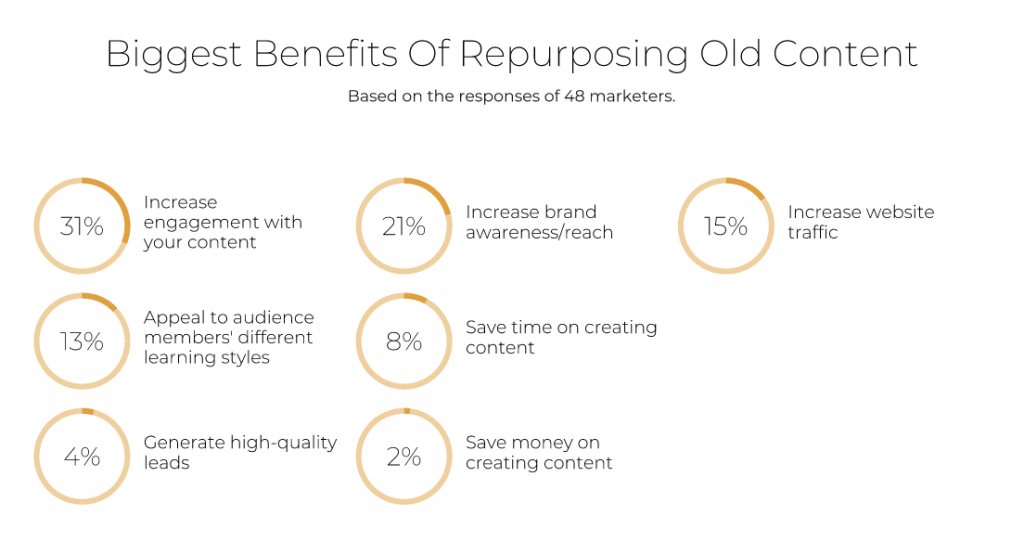
Image source: Referral Rock
⚠️While repurposing sounds great, it’s not always easy.
Maybe you’ve tried it before but felt overwhelmed by the process.
How do you decide what content to repurpose? How do you ensure it doesn’t feel repetitive?
The key is to have a strategy. In this guide, I will walk you through nine ways to repurpose content so that it becomes a seamless part of your workflow.
9 Ways to Repurpose Your Blog Content
If you have evergreen content, that is the best type of blog you want for repurposing content. By turning existing pillar posts into something new, you can create an endless stream of fresh content that attracts new audiences.
Here are nine ways how to repurpose your blog effectively.
1. Turn Written Content Into Visual Content
People process visuals faster than text.
It only takes 13 milliseconds for the human brain to process an image — 60,000 times faster than processing written text!
In fact, 90% of all information transmitted to the brain is visual.
The picture superiority effect also tells us that images are more memorable than text.
If you’ve written a 2,000-word blog post that only a few people are enjoying reading, you could turn it into something visually engaging.
Infographics
Does your post contain important data or step-by-step processes? Turn these into visually appealing infographics that make it easier for viewers to skim through.
Compared to black-and-white text, colorful infographics are easier to share on Twitter, Instagram, or Pinterest to reach more people.
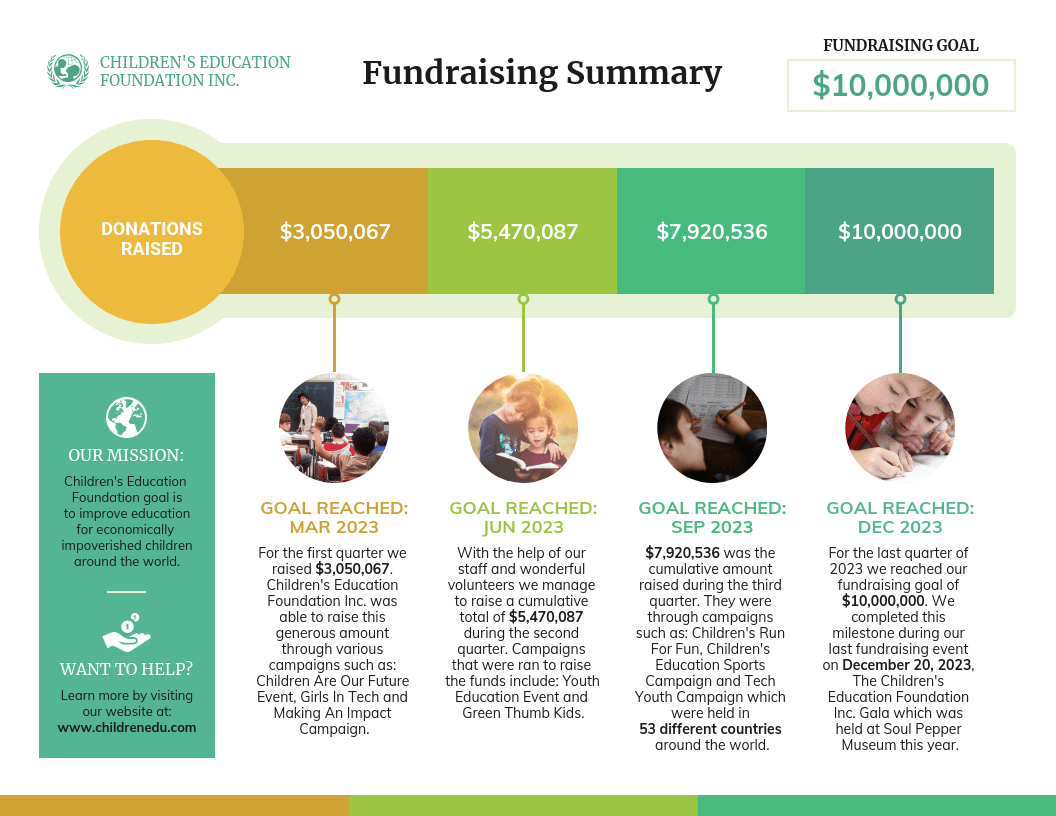
Image source: Venngage
Tools to use: Canva, Piktochart, Visme, Venngage, Adobe Express
Quote Cards
Do you have a quote from one of your posts that is worth highlighting? Take this quote and turn it into an eye-catching image with a beautiful background or font design. This makes it much more likely to be shared on social media channels.
For example:
If your blog says, “SEO is a long game, not a quick win,” turn that into a motivational LinkedIn post.
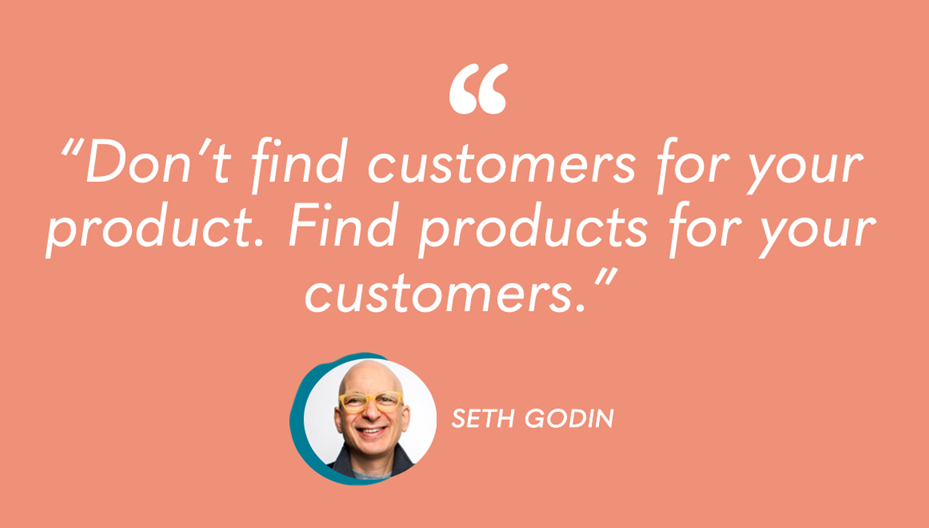
Slide Decks
Repurposing content into slide decks is a great way to present information in a visual, digestible, and engaging format. Slide decks work well for turning long “how-to” guides into LinkedIn posts, webinars, presentations, and platforms like SlideShare or Google Slides.
✔️ Break down your blog post or article into short, impactful slides. Each slide should focus on one key takeaway.
✔️ Avoid text-heavy slides. Use bold headings, bullet points, images, and infographics to make content engaging.
✔️ Create a story flow with a Title Slide, Intro, One Key Point Per Slide, Conclusion, and CTA
For example:
A blog post titled “10 Marketing Strategies for Small Businesses” can be repurposed into:
- A LinkedIn Slide Deck: One strategy per slide with bullet points.
- A Webinar Presentation: Expanded insights for an audience.
- A SlideShare Upload: SEO-friendly exposure for professional readers.
Here’s a slide deck we created with Canva:
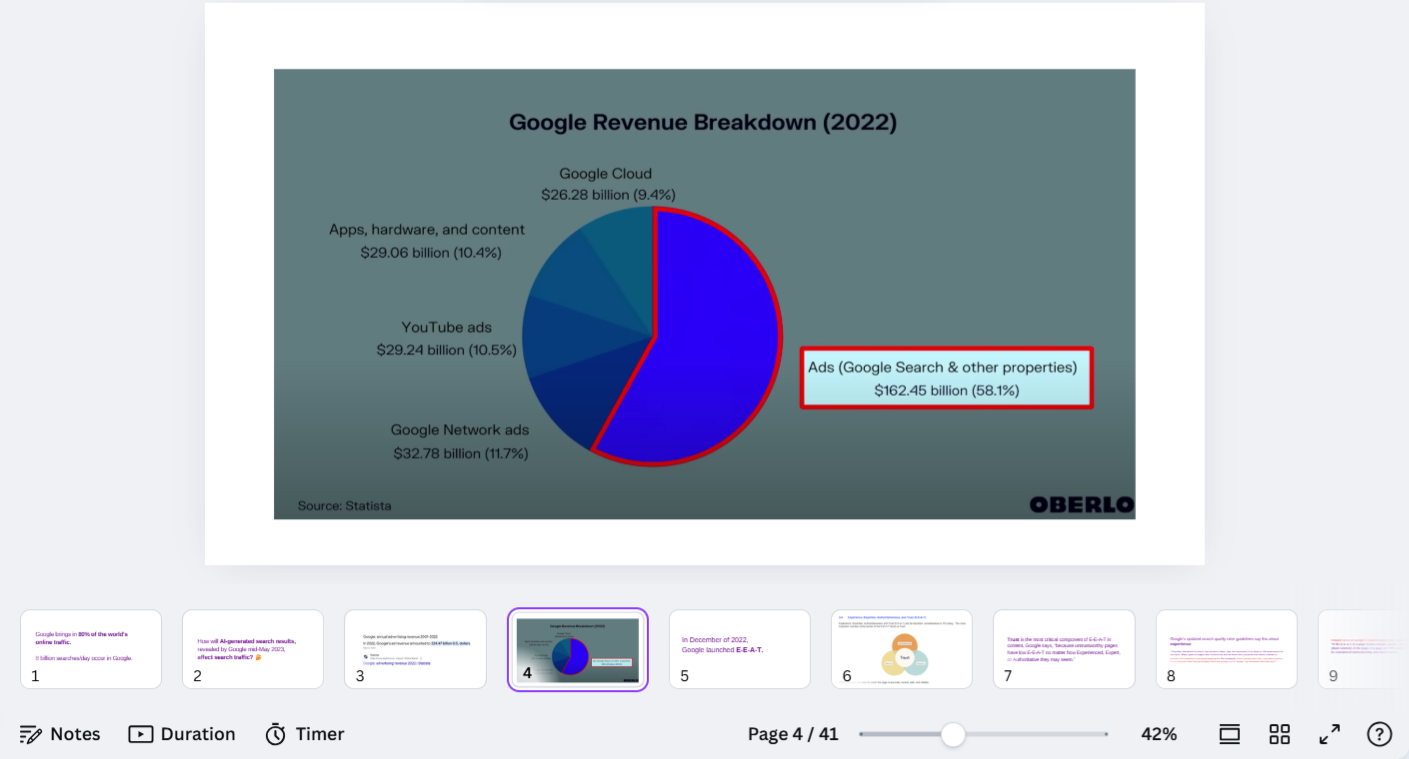
Tools to use: Microsoft PowerPoint, Google Slides, Canva, Visme, SlideShare
2. Convert Text into Different Formats
Your written content doesn’t have to stay in text form — repurpose it into audio or video formats for new audiences.
Videos
Turn your blog ideas into video scripts and create informative videos or animated explainers. This could be short tutorials like how to bake a cake, an interview with an industry expert like a financial guru, or even just slideshows summarizing key points from the article – all of which would work well on YouTube and Vimeo.
Another way to repurpose content into videos is to turn blog takeaways into snackable videos for TikTok, Instagram Reels, or YouTube Shorts.
E-books
Do you have a series of blog posts written on one topic? Why not compile them into an ebook? This gives readers easy access to tons of valuable information without having to spend hours scrolling through each individual article.
Plus, ebooks look great online and attract attention due to their longer format. Combine related blog posts into a downloadable lead magnet.
Here’s an example of how AdEspresso repurposed its blog post into an ebook lead magnet: (both are ranking on Page One!)
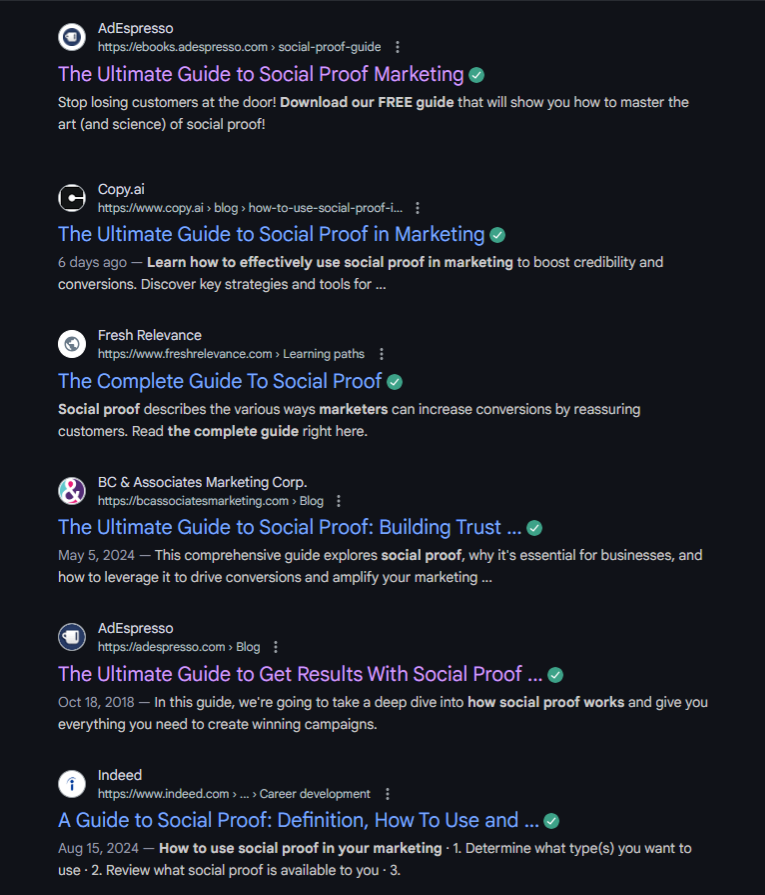
Podcast Episodes
Use your blog post as a script for a podcast episode. Add personal stories, extra commentary, and guest insights.
Do you have any audio recordings related to one of your articles? Consider turning those into podcasts that you can distribute across podcasting networks like iTunes, Stitcher, and Google Play Music. People who don’t have time to read can gain access to your information even when they’re in the car or out running.
Tools to use: Descript, Anchor (Spotify for Podcasters), Canva, InVideo
Image Galleries
Repurposing images as a gallery (carousel) on social media is a great way to boost engagement and present information in a visually appealing, swipe-friendly format.
✔️ If your blog has multiple images, infographics, or screenshots, combine them into a LinkedIn or Instagram carousel.
✔️ You can also create a step-by-step series and break them down into separate slides, using images to illustrate each step.
✔️ If you have transformation photos (e.g., design improvements, case study results, or product updates), format them into a comparison gallery.
✔️ Instead of posting one long infographic, split it into multiple slides for better readability.
✔️ If you have data-driven images or quotes, present them in a swipe-through gallery for easy consumption.
Some of the best platforms for carousels are:
- Instagram Carousel Posts (max 10 slides)
- LinkedIn Carousels (upload as PDFs for a smooth slide effect)
- Facebook Album Posts
- Pinterest Idea Pins (great for storytelling)
Tools to use: Canva, Piktochart, Visme, Venngage
Checklists
Break down complex processes mentioned in certain blogs by creating checklists. For example, if you wrote a blog post about baking a cake, you could break down each step into items on a checklist. This will make it easier for your readers to follow your recipe.
Here’s a cupcake recipe checklist shared on Pinterest.

3. Update and Refresh Old Content
Instead of constantly writing brand-new content, refreshing and republishing old blog posts is one of the easiest ways to keep your website fresh, improve SEO, and maintain traffic.
Search engines favor up-to-date, relevant content, so breathing new life into your existing articles can boost rankings and engagement with minimal effort.
Update Statistics and Outdated Information
If your blog post contains stats, research, or trends, check whether they are still accurate. Outdated numbers can reduce credibility and hurt SEO rankings.
✔️ Look for new industry reports, surveys, or case studies to replace old data.
✔️ Cite reputable sources (Google Trends, Statista, industry whitepapers).
✔️ Update dates in your content, such as “Best SEO Tips for 2023” → “Best SEO Tips for 2025.”
Add New Examples, Case Studies, or Success Stories
Examples help illustrate concepts and make your content relatable. If your original post used outdated case studies or examples, replace them with new, relevant ones.
✔️ Include recent success stories, product updates, or case studies.
✔️ Mention how new strategies have evolved.
✔️ Use fresh screenshots or testimonials to add credibility.
Expand the Content
Older blog posts may feel shallow or outdated as industries evolve. Expanding them can increase word count, add depth, and improve SEO rankings.
✔️ Break down subtopics into detailed sections.
✔️ Check Google’s People Also Ask section and answer new common questions readers might have.
✔️ Add FAQs, additional steps, or new insights.
Optimize for SEO
Search engines reward updated, well-structured content, so optimizing old posts can improve rankings and drive new traffic.
✔️ Research new long-tail keywords and add them naturally.
✔️ Improve formatting with shorter paragraphs, bullet points, and better readability.
✔️ Interlink updated articles with newer content for better navigation.
✔️ Optimize images (ALT text, compressed size, relevant file names).
Republish on Other Platforms for More Exposure
Once updated, don’t let your content sit on your blog — republish it on other platforms to extend reach and attract a fresh audience.
- Medium: Great for tech, marketing, and business content.
- LinkedIn: Ideal for B2B and professional readers.
- Reddit & Quora: Answer questions and link back to your blog.
Tools to use: Google Search Console or BrandWell (to find declining posts), Clearscope for content analysis
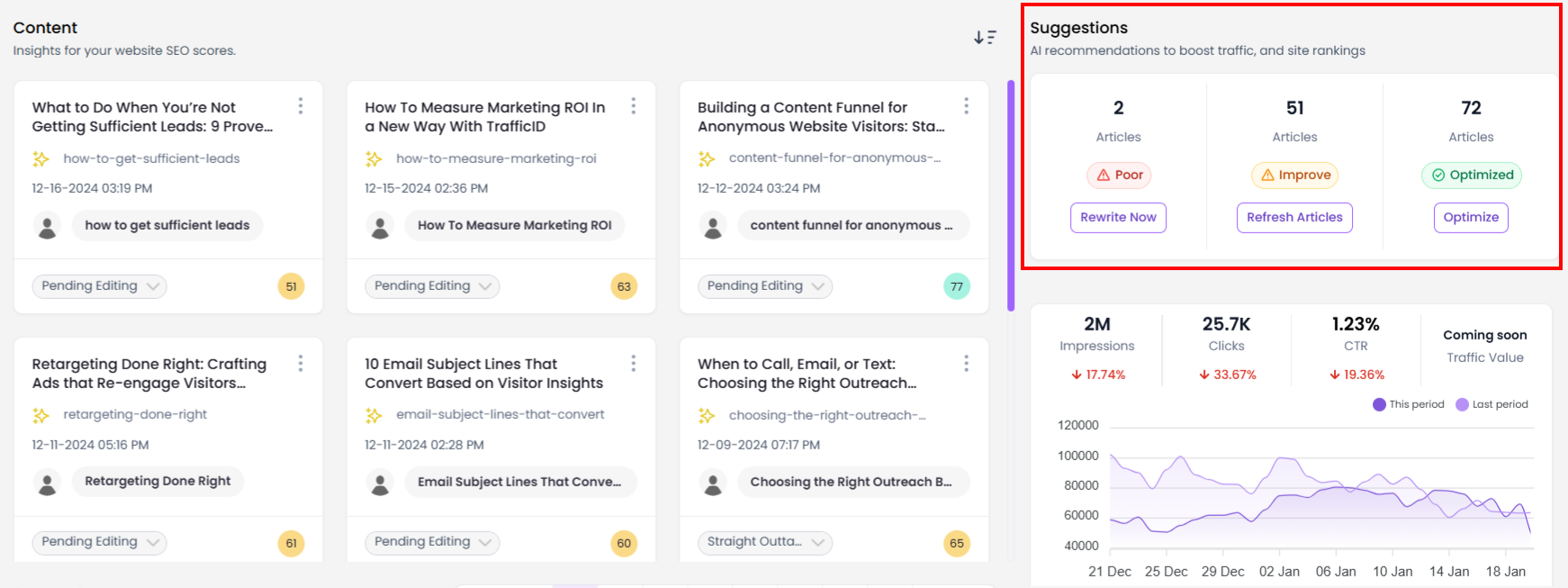
A screenshot of BrandWell’s website audit
4. Repurpose Long-form Content for Social Media
Your blog post is a goldmine of content — so don’t let it sit idle!
Break it into bite-sized pieces and share it across social media to reach new audiences, boost engagement, and drive traffic back to your website.
Snippets
Not everyone has time to read a full blog post. Break it down into digestible insights and share them as quick updates.
✔️ Extract one valuable tip or insight and post it with a call-to-action (CTA) to read the full article.
✔️ Use numbered lists or bullet points for better readability.
✔️ End posts with a question or prompt to spark engagement.
For example:
Want to improve your email open rates?
📌 Keep subject lines under 50 characters
📌 Personalize with the recipient’s first name
📌 Test emojis vs. no emojis to see what works best👉 Read the full guide: [yourblog.com]
Best platforms for sharing snippets: LinkedIn, Facebook, Twitter, Threads
Teasers
Create excitement for new blog posts, product launches, or updates by teasing upcoming content on social media.
✔️ Share a compelling question or statistic from the blog without revealing everything.
✔️ Offer a sneak peek of a major insight and direct followers to the full article.
✔️ Use countdowns or polls to spark curiosity and engagement.
For example:
Coming soon: “The Ultimate Guide to AI Copywriting”
Want to double your content output while saving time? We’ll show you how.
Stay tuned! 🔥
Best platforms for posting teasers: Instagram Stories, Twitter, LinkedIn
Audiograms
Turn key blog insights into short audio clips with waveform animations and share them as engaging social media posts.
✔️ Record a short voiceover summarizing the blog’s main point.
✔️ Use tools like Headliner, Wavve, or Audiogram to create animated clips.
✔️ Pair the audio with relevant visuals or captions.
For example:
A blog post on “How to Overcome Writer’s Block” could become an audiogram with a voiceover:
🎙️ “One trick for beating writer’s block? Start by writing the worst possible version of your idea. Progress over perfection!”
Best platforms for sharing audiograms: Instagram Reels, TikTok, LinkedIn, Facebook
LinkedIn Posts
LinkedIn users love in-depth, insightful content — so take one section of your blog and expand on it with new insights or personal experiences.
✔️ Rewrite one section of your blog post as a standalone LinkedIn post.
✔️ Add your own take or a personal story for authenticity.
✔️ Use bullet points, lists, and storytelling for better engagement.
For example:
A blog on content marketing strategies could become a LinkedIn post like:
Why Most Content Fails to Rank on Google (And How to Fix It)
I used to write blog posts that got ZERO traffic. Then I discovered one simple strategy that changed everything: content repurposing.
Here’s how I turn one blog post into 10+ pieces of content: 👇
Facebook & Instagram Posts
Repurpose blog content into short, engaging captions that highlight major takeaways.
✔️ Turn key tips into carousel posts or short captions.
✔️ Add emojis, storytelling, or humor to make posts relatable.
✔️ Include a CTA, e.g., “Save this for later” or “Read more at [yourblog.com]”.
For example:
3 Ways to Write Headlines That Get Clicks
✨ Keep it under 8 words for clarity.
✨ Use numbers: “7 Proven Ways to Boost Sales”
✨ Tap into curiosity: “You’re Making These SEO Mistakes (Here’s How to Fix Them)”
Twitter Threads
Break down your blog post into a series of connected tweets to create a highly engaging Twitter thread.
✔️ Start with a hook tweet to grab attention.
✔️ Share one key point per tweet in a logical sequence.
✔️ End with a call-to-action (CTA) linking to the full article.
For example:
Want more traffic to your blog? Try these 5 powerful SEO hacks 👇
1️⃣ Optimize for long-tail keywords (they’re easier to rank for).
2️⃣ Use internal links to boost page authority.
3️⃣ Add FAQ sections for Google’s Featured Snippets.
4️⃣ Repurpose content into videos, infographics, and carousels.
5️⃣ Promote old posts on social media & email newsletters.👉 Full guide here: [yourblog.com]
Here’s an example of a Twitter thread created with Chirr App:
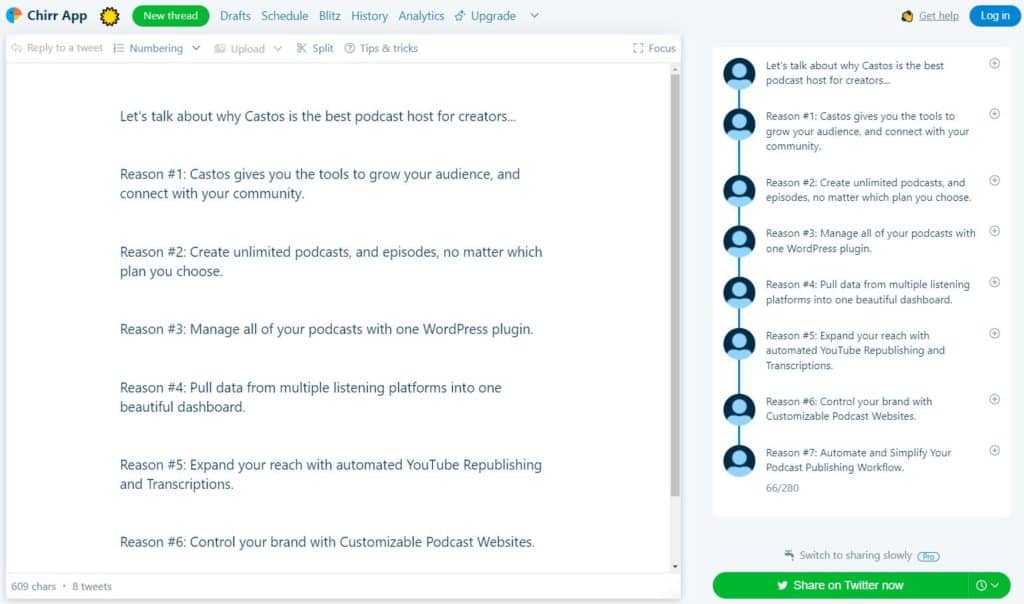
Tools to use: Buffer, Hootsuite, Missinglettr
5. Rewrite Blog Posts Into Guest Posts
Guest posting is one of the best ways to repurpose your existing blog content while building authority, backlinks, and brand visibility.
Instead of starting from scratch, take a well-performing blog post, tweak it for a new audience, and publish it on high-authority websites in your niche.
Choose the Right Blog Post to Repurpose
Not all blog posts are ideal for guest posting. Focus on:
✔️ High-performing posts – Topics that already get traffic, engagement, or rank well on Google are likely to resonate with new audiences.
✔️ Content that aligns with the target site’s audience – If a site focuses on B2B marketing, repurpose content that caters to that niche.
For example:
If your blog post “10 SEO Mistakes Bloggers Make” performed well on your site, you can rewrite it for an SEO-focused publication with a fresh angle like:
“How to Fix Common SEO Mistakes That Hurt Your Rankings”
Rewrite with a Fresh Angle
Guest posts shouldn’t be carbon copies of your original blog post. Instead, adapt the content to match the tone, audience, and style of the host website.
✔️ Adjust the tone: A casual blog post may need a more professional tone for a business website.
✔️ Modify the focus: Shift the emphasis slightly to match the interests of the new audience.
✔️ Personalize examples: Use case studies or industry-specific examples relevant to the target publication.
For example:
If your original post was “The Best AI Writing Tools for Bloggers”, you could rework it for a business-focused site as:
“How AI Writing Tools Are Changing Content Marketing in 2025”
Add New Insights and Examples
To ensure originality and avoid duplicate content issues, always:
✔️ Include updated statistics – Refresh data to keep your post relevant.
✔️ Incorporate new case studies or success stories – Use fresh examples to support your points.
✔️ Reword key sections – Don’t copy-paste! Rewrite using different phrasing and additional details.
For example:
If your original blog post had a 2023 statistic, update it with 2025 research in your guest post to add value and make it unique.
Include a Backlink to Your Original Post for Extra Traffic
Guest posting is not just about exposure — it’s a strategic way to drive traffic back to your site. Most websites allow you to include at least one backlink to your original content.
Where to add backlinks:
- Within the content – Naturally reference your blog post as a source.
- In your author bio – Include a CTA linking back to your blog.
For example:
At the end of your guest post, you could include:
“Want to dive deeper into AI writing tools? Check out my full breakdown here: [yourblog.com].”
Find Guest Posting Opportunities in Your Niche
To make the most of repurposing blog content into guest posts, submit to reputable websites that align with your industry.
✔️ Look for industry blogs, online magazines, and business websites that accept guest contributions.
✔️ Search Google for “[Your Niche] + Write for Us” (e.g., “Digital Marketing + Write for Us”).
✔️ Pitch websites where your audience already hangs out.
Best Guest Posting Platforms:
- Marketing & SEO: Moz, HubSpot, Content Marketing Institute
- Tech & SaaS: TechCrunch, Smashing Magazine
- Business: Entrepreneur, Forbes, Inc.
6. Turn Listicles into Visual Lists
If your blog post is a listicle, you already have ready-made content that can be repurposed into visually engaging formats.
Instead of keeping your list text-heavy, break it down into easy-to-digest visuals that perform better on social media and other platforms.
Create Carousel Posts
Carousels are multi-slide posts that let you present list items in a swipeable format, making them perfect for engagement.
✔️ Use tools like Canva, Adobe Express, or Figma to design slides.
✔️ Each slide should feature one key point from your listicle.
✔️ Keep text minimal and use bold visuals or icons to highlight each item.
✔️ End with a call-to-action (CTA) encouraging comments, shares, or saves.
For example:
If your blog post is about “10 Productivity Hacks for Remote Workers”, you could create:
Slide 1: Title – “10 Productivity Hacks for Remote Workers”
Slides 2-10: Share one tip per slide with visuals and a short explanation.
Final Slide: CTA – “Which hack do you use? Comment below!”
Best platforms for carousels: Instagram, LinkedIn, Facebook
Design Infographics
Infographics turn listicles into digestible, shareable images that simplify complex ideas.
✔️ Summarize your listicle into a single infographic.
✔️ Use color-coded sections for each point.
✔️ Add icons, graphs, or simple illustrations to enhance understanding.
✔️ Use a vertical format (1000x1500px or taller) for better visibility.
For example:
If your blog post is about “7 Email Marketing Mistakes to Avoid”, create an infographic showing:
Mistake 1: Weak subject lines
Mistake 2: Sending too many emails
Mistake 3: No personalization
Each list item can become a standalone pin on Pinterest.
Best platforms for infographics: Pinterest, Twitter/X, LinkedIn
Convert Lists into Shorts & Reels
Short-form videos are exploding in popularity, making them perfect for repurposing listicles into quick, engaging clips.
✔️ Film yourself explaining each list item.
✔️ Add text overlays and animations for better retention.
✔️ Use fast cuts and energetic background music to keep viewers engaged.
✔️ End with a CTA, e.g., “Follow for more tips!” or “Read the full blog at [yourblog.com]”.
For example:
A post like “10 Best AI Tools for Blogging” could become:
- A LinkedIn carousel: “Swipe to see the best AI writing tools”
- A TikTok video: “I tested 10 AI tools—here are my top 3!”
You can also create a Top 5 or Top 10 countdown video.
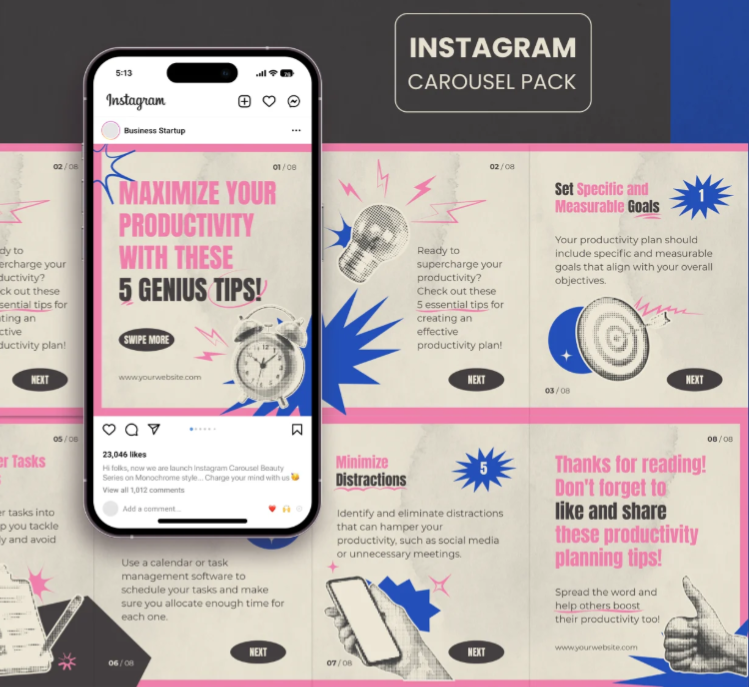
Best platforms for short videos: Instagram Reels, TikTok, YouTube Shorts
7. Turn Blog Posts Into Newsletter Content
Your email subscribers are some of your most loyal followers, but they don’t always check your blog regularly.
By repurposing blog posts into newsletter content, you keep them engaged, informed, and coming back for more — without having to create entirely new material.
Break a Blog Post Into a Weekly Email Series
Instead of overwhelming subscribers with one long email, break your blog post into a multi-part email series to keep them engaged over several weeks.
✔️ Choose a comprehensive blog post with multiple sections.
✔️ Split it into 3–5 short, digestible emails (each focusing on one key point).
✔️ End each email with a teaser for the next email, so subscribers stay interested.
For example:
If your blog post is about “The Ultimate Guide to SEO in 2025”, create an email series like this:
Email 1 (Introduction) – Why SEO is Changing in 2025 + What to Expect
Email 2 – Keyword Research: How to Find the Best Keywords
Email 3 – On-Page SEO Strategies for Higher Rankings
Email 4 – Off-Page SEO: Link Building & Authority Growth
Final Email (CTA) – Putting It All Together + Link to Full Blog Post
Best for: Evergreen blog posts, step-by-step guides, long-form content
Summarize Key Takeaways & Add Extra Insights
Some blog posts are too long for email, so summarizing key takeaways helps subscribers get value without needing to read the entire post.
✔️ Pick 3-5 actionable takeaways from your blog post.
✔️ Write them in a concise, engaging format.
✔️ Add extra insights or personal commentary to provide exclusive value.
For example:
If you have a blog post about “5 Time Management Hacks for Busy Entrepreneurs”, your email might look like this:
Subject: 5 Productivity Hacks Every Entrepreneur Should Know
Hey [First Name],
Struggling to stay productive? Here are 5 quick hacks to help you get more done:
Hack #1: The 80/20 Rule – Focus on the 20% of tasks that bring 80% of results.
Hack #2: The 2-Minute Rule – If a task takes less than 2 minutes, do it immediately.
Hack #3: Batch Similar Tasks – Group similar tasks to reduce mental switching.Want the full breakdown? Read the complete guide here: [YourBlog.com]
Best for: Listicles, tutorials, productivity tips, marketing strategies
Drive Traffic Back to Your Blog
Your email should tease your blog post without giving away everything — so subscribers have a reason to click through to your website.
✔️ Use curiosity-driven subject lines to entice opens.
✔️ Share a short intro + 1-2 key points from the blog post.
✔️ Add a compelling CTA to encourage clicks.
For example:
Subject: Are You Making This Blogging Mistake?
Hey [First Name],
Most bloggers struggle with getting traffic, but one simple mistake could be holding you back:
Not updating old content. If your blog posts are outdated, Google won’t rank them. Here’s what you can do:
✔️ Refresh stats and examples
✔️ Add new insights
✔️ Optimize for new keywordsWant to learn how to fix this mistake and rank higher? Read the full blog here: [YourBlog.com]
Best for: Educational content, SEO & marketing strategies, long-form guides
Customize Your Blog Content for Your Email Audience
Your email audience may differ from your blog audience, so adjust the tone, focus, or structure to make it more personal.
✔️ Write in a friendly, conversational tone.
✔️ Add personal stories or insights.
✔️ Use exclusive content or bonuses not found in the original blog.
For example:
If your blog post is about “How to Get More Leads with LinkedIn”, you could:
- Add a personal story about how you got 5 high-quality leads in a week.
- Include a bonus LinkedIn profile template just for email subscribers.
Best for: Thought leadership, case studies, personal branding
Use a Blog Post as the Foundation for an Exclusive Email Course
Turn an educational blog post into a free email course to build trust and nurture leads.
✔️ Choose a blog post that teaches a skill.
✔️ Break it down into a step-by-step learning sequence.
✔️ Send 1 email per day (or week) with a clear action step.
For example:
If you have a blog post about “A Beginner’s Guide to Affiliate Marketing”, create a 5-day email course like this:
Day 1: What is Affiliate Marketing? (Overview & Benefits)
Day 2: How to Find Profitable Affiliate Programs
Day 3: Creating Content That Drives Affiliate Sales
Day 4: SEO & Social Media Strategies for More Traffic
Day 5: How to Scale Your Affiliate Business
At the end of the course, offer a paid product or coaching session as an upsell.
Best for: Online businesses, course creators, digital marketing topics
The image below demonstrates how Moz shares its Top 10 original and curated blog posts in its semi-monthly email newsletter.

8. Conduct Live Events
Why just write about a topic when you can talk about it live and engage with your audience in real time?
Conducting live events allows you to connect with your audience, answer questions directly, and reinforce your expertise — all while repurposing your blog content.
Host Instagram or Facebook Live Sessions
Live videos on Instagram and Facebook get more engagement than regular posts because they feel personal and interactive.
Choose a popular blog post topic and go live to discuss key takeaways, share updates, or answer audience questions.
For example:
If you wrote a blog post on “How to Get Quality Backlinks for Your Blog,” host a live session on “Backlink Strategies That Actually Work” and break down actionable tips.
Ask your viewers to drop questions in the comments so you can answer them in real time.
Live Q&A Sessions
Your audience has burning questions — why not let them guide the discussion?
Before going live, ask your followers what they want to know about your blog’s topic.
You can collect questions through:
- Instagram Stories (Polls & Question Stickers)
- Twitter/X Threads & Replies
- Email List Surveys
For example:
If you have a blog post on productivity tips, ask your audience, “What’s your biggest struggle with staying productive?”
Answer their specific pain points live while referencing insights from your blog.
Host Webinars
Webinars allow for deeper discussions, screen-sharing, and interactive elements like polls and live chat.
Use a blog post as the foundation for a structured webinar and offer additional insights. Invite guest speakers who specialize in that topic and allow viewers to ask questions during your live event.
You can:
✔️ Expand on blog topics with real-world case studies & examples
✔️ Include slides or visuals to reinforce key points
✔️ End with a Q&A session to keep engagement high
For example:
A blog post about “SEO Strategies for 2025” can turn into a webinar titled “The Future of SEO: How to Stay Ahead in 2025.”
Offer a free checklist or template (lead magnet) to encourage sign-ups
Tools to use: Zoom, WebinarJam, Google Meet, Demio
Twitter/X Spaces & LinkedIn Audio Events
Not comfortable on camera? Audio-only live sessions on Twitter/X Spaces and LinkedIn Audio Events let you engage without video pressure.
Start a discussion on a trending topic from your blog and invite industry experts or your followers to join the conversation.
For example:
If you wrote a blog post on “AI Tools for Affiliate Marketing,” host a Twitter Space on the same topic and share key insights while taking listener questions.
Invite guest speakers or influencers to add credibility and attract a larger audience.
Tools to use: Twitter Spaces, LinkedIn Audio Events, Clubhouse
Host YouTube Live Shows
YouTube Live is great for teaching complex topics, engaging in real-time, and saving content for future viewers.
Repurpose blog content into a structured live session with:
✔️ Bullet-pointed discussion topics from the blog post
✔️ Live screen-sharing to walk through tutorials or examples
✔️ Chat engagement (answering questions from viewers)
For example:
A blog post about “How to Write an Ebook” can turn into a live walkthrough on formatting, design, and publishing.
Once the live session ends, upload the video as a replay and embed it back into the original blog post for added engagement.
Tools to use: YouTube Live, OBS Studio for screen-sharing
Instagram & TikTok Live Challenges
Challenges create engagement, community participation, and motivate your audience to take action.
Turn a blog post into a challenge where participants follow daily or weekly steps.
For example:
If your blog post is about “30-Day Content Marketing Strategies,” turn it into an Instagram Live Challenge where you go live every week with actionable tasks.
Encourage users to tag you or use a hashtag to showcase their progress.
In-Person Events
If you have a blog post that’s targeted towards a local audience, consider hosting an in-person event to further increase the visibility of your product or service. Inviting potential clients will strengthen the brand-customer relationship while establishing yourself as an authority in the industry.
9. Turn Blog Posts into Online Courses
Some blog topics are deep enough to become a structured online course. If you have multiple posts on a subject, bundle them into lessons.
Transforming a series of blog posts into an online course can provide your audience with a comprehensive learning experience. By creating video lessons, quizzes, and assignments, you are not only repurposing your existing content but also monetizing your expertise.
For example:
A series of blog posts on “How to Start an Online Business” could become a step-by-step beginner’s course on Teachable or Thinkific.
Tools to use: Teachable, Thinkific, Podia
Remember, each platform has its own audience, so it’s essential to customize the repurposed content to suit the format and preferences of the platform you’re targeting. Also, ensure that the content is updated and relevant to provide value to both new and existing audiences.
User-Generated Content: A Unique Way to Repurpose Content
User-generated content (UGC) is any form of content that has been posted by users online. These include photos, videos, text, and audio.
You’ve seen customer testimonials before, and you know how powerful they are as tools for authenticity.
Your customers’ experiences can be gold mines for updating older content.
By integrating these within your existing blogs, you can repurpose content without creating entirely new material.
Think about it: real-life reviews or experiences provide relatable insights. These not only engage readers but also refresh your long-form blog posts with valuable perspectives.
✔️ Extract positive testimonials from blog comments, social media replies, or emails.
✔️ Design quote graphics for Instagram, LinkedIn, or Pinterest.
✔️ Create a testimonial carousel post on LinkedIn or Facebook.
✔️ Turn multiple testimonials into a case study or success story blog post.
For example:
If you wrote a blog on “Best AI Writing Tools,” take real user comments from Twitter or LinkedIn about their experiences with different AI tools and turn them into a comparison infographic or video.
Here’s a Canva template for launching a UGC campaign:

Remember when we said earlier that repurposing means taking existing blog posts and giving them a new life? Well, here is an actionable way.
Add those sparkling reviews directly into relevant sections of your old articles. This will give them more depth while keeping things interesting for the reader.
How to Repurpose Your Blog Effectively
To effectively repurpose content, the first step is to select new marketing platforms that will extend the reach and audience interaction of your popular content. For example, quotes or memes are best shared on Twitter. If you want to create visuals like infographics or videos, then Instagram or YouTube might be better options.
Once you’ve identified the right platform(s), it’s time to create content from the core of your popular posts. Spin the old title of your blog post into an intriguing headline to entice readers to click through. Add fresh keywords from your latest keyword research list so you can target new visitors.
If you’re looking to repurpose old written content for a younger audience, add images, infographics, or videos to draw interest and keep them engaged.
Optimizing your posts for maximum reach is also important when repurposing a blog for new media. Take advantage of features like hashtags on Twitter or geotagging on Instagram to push your content in front of its intended audience.
Pay attention to peak posting times when scheduling your posts. Take note of periods when activity is high so more people will see your social media posts.
Encourage your followers to submit their own photos using your products. User-generated content can help build brand loyalty and organic reach — making it a valuable asset when optimizing repurposed blog content for social media.
💡Pro Tips:
- Identify Evergreen Content: When choosing blog posts to repurpose, focus on topics that are timeless and valuable rather than trend-based. These will continue to perform well across different formats.
- Start with Long-Form Content: Find your longest, deep-dive content first. Articles that have 3,000+ words usually cover a topic in-depth, making it much easier to clip and snip.
- Tailor Content for Each Platform: A LinkedIn post might need a more professional tone, while a TikTok video should be playful and engaging. Formatting can also vary for different platforms — your blog post on WordPress might look totally different on Quora.
- Always Add New Value: Don’t just copy-paste from a previous asset. Take a unique angle that fits the new format or is based on what’s currently trending in the market while keeping the main ideas intact. Add insights, examples, or visuals to make the repurposed content feel fresh.
Examples of Successful Blog Post Repurposing
If you’re still not sure about how to reuse blog material, here are some examples of successful cases of repurposing content.
- Coca-Cola transformed its corporate website into an engaging digital magazine called “Journey“. This was not just updating older content — it was total reinvention.
- Moz took the idea of repurposing content to another level with its “Whiteboard Fridays” where an old post is presented as a video tutorial. Talk about giving your long-form blog content new life.
- In his book Crushing It, author Gary Vaynerchuk (Gary Vee) talks extensively about how he creates 30+ social media posts from just one keynote speech.
- National Geographic takes snippets from their articles or shows and shares them as compelling captions on Instagram. In doing so, they have amassed over 100 million followers.
It goes without saying that this strategy has certainly paid off.
Repurpose your Content with BrandWell
BrandWell makes it easy to repurpose existing articles, videos, and podcasts into original long-form posts.
As you can see in the image below, you can still create content from scratch based on a target keyword. But if you already have content that’s really performing well, you can now turn it into a new 2,500-word blog post with the simple click of a button.
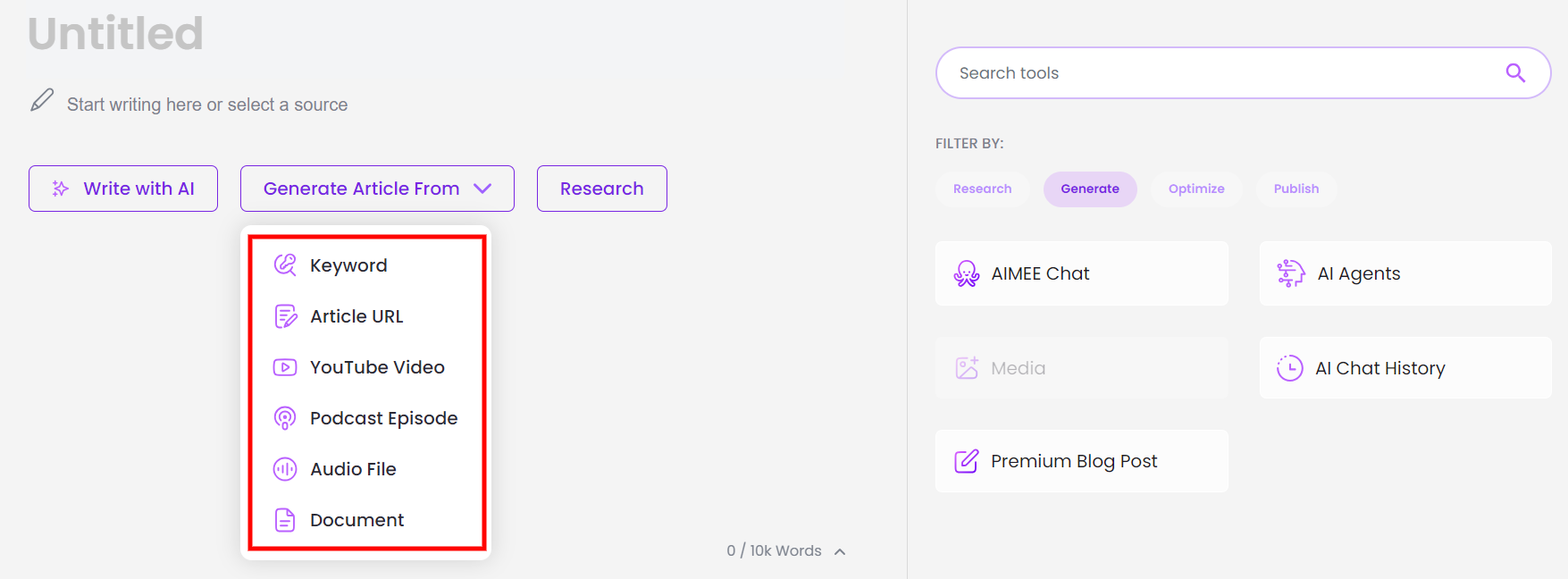
For example, we used BrandWell to repurpose this YouTube video interview …
Into this blog post case study:
Challenges in Repurposing Content
While repurposing content can offer many benefits, it’s essential to be aware of the potential challenges that may arise during the process.
Maintaining Originality: Repurposing content should involve transforming it into new formats or adjusting it for different platforms, but it’s crucial to maintain originality and avoid duplicating content. Duplicate content can hurt your SEO efforts and may be flagged by search engines as low-quality.
Adapting to Different Formats: Not all content translates well to different formats. Some topics may be better suited for written articles, while others might work better as videos or infographics. Adapting content to different formats while ensuring it remains engaging and effective can be challenging.
Content Saturation: If a particular piece of content is repurposed too frequently or across too many channels, it can lead to content saturation. When audiences see the same content repeatedly, they may become less receptive to it or perceive it as spammy.
Relevance and Timeliness: Some content may not be evergreen, and repurposing it without updating relevant information can lead to outdated or irrelevant content being circulated.
Intellectual Property Concerns: When repurposing content created by others or using third-party assets like images or graphics, ensuring proper attribution and permissions is crucial to avoid copyright infringement.
To overcome these challenges, it’s essential to have a well-thought-out content repurposing strategy. Focus on adding value to your audience, adapt content creatively, and avoid spammy or repetitive behavior.
FAQs – How to Repurpose Your Blog
How to repurpose your blog content?
To repurpose your blog content, transform it into different formats to reach a wider audience. Here’s how:
- Create visuals – Turn key takeaways into infographics or quote cards.
- Convert to video – Make explainer videos, reels, or YouTube tutorials.
- Start a podcast – Use blog content as a script for an audio version.
- Republish as a guest post – Rewrite and submit to industry blogs.
- Share on social media – Extract snippets for LinkedIn, Twitter, or Instagram.
- Bundle into an ebook – Combine related posts into a downloadable guide.
What is an example of repurposed content?
An example of repurposed content is turning a blog post about “10 SEO Tips” into:
- A Twitter thread summarizing each tip.
- A LinkedIn carousel with key insights.
- A YouTube explainer video discussing SEO strategies.
- An infographic highlighting the 10 tips for Pinterest.
- A webinar or live Q&A session about SEO trends.
How do I reuse my existing content in a new way?
You can reuse existing content by adapting it for different platforms and formats:
- Update and refresh old blog posts with new stats and insights.
- Break long articles into bite-sized social media posts.
- Turn step-by-step guides into an online course or webinar.
- Extract key points for an email newsletter.
- Use blog quotes in Instagram posts or LinkedIn updates.
What is an example of repurposing?
An example of repurposing is converting a blog post into a video. For instance, a written guide on “How to Start a Blog” can be repurposed into:
- A YouTube tutorial explaining the steps.
- A TikTok or Instagram Reel with quick blogging tips.
- A Podcast episode discussing common blogging mistakes.
- A Checklist PDF summarizing the process for lead generation.
Repurposing content helps maximize reach, engagement, and SEO impact while saving time on content creation.
Conclusion
Learning how to repurpose your blog effectively can extend the reach and engagement of your old content.
Whether you use social media or other methods to promote your repurposed blogs, always remember that quality should be at the forefront when crafting any type of message for redistribution.
It’s time to give your outdated content a makeover. Sign up for BrandWell today.

UNLOCK YOUR POTENTIAL
Long Headline that highlights Value Proposition of Lead Magnet
Grab a front row seat to our video masterclasses, interviews, case studies, tutorials, and guides.

